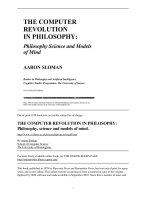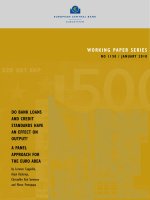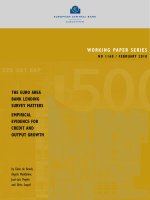ECONOMIC OUTLOOK FOR THE EURO AREA IN 2011 docx
Bạn đang xem bản rút gọn của tài liệu. Xem và tải ngay bản đầy đủ của tài liệu tại đây (103.44 KB, 11 trang )
1
EFN REPORT
ECONOMIC OUTLOOK FOR THE
EURO AREA IN 2010 and 2011
Autumn 2010
2
About the European Forecasting Network
The European Forecasting Network (EFN) is a research group of European institutions,
founded in 2001 under the auspices of the European Commission, and currently partly
financially supported by the Schuman Centre at the European University Institute. The
objective of the EFN is to provide a critical analysis of the current economic situation in
the euro area, short-term forecasts of the main macroeconomic and financial variables,
policy advice, and in-depth study of topics of particular relevance for the working of the
European Economic and Monetary Union. The EFN publishes four quarterly reports.
Further information on the EFN can be obtained from our web site,
www.efn.uni-
bocconi.it or by e-mail at .
Participating Institutions:
Robert Schuman Centre, European University Institute (Coordinator)
Team Leader: Massimiliano Marcellino ()
Centre d´Etudes Prospectives et d´Informations Internationales (CEPII)
Team Leader: Lionel Fontagné ()
University of Birmingham, Department of Economics
Team Leader: Anindya Banerjee ()
The Halle Institute for Economic Research (IWH)
Team Leader: Axel Lindner ()
The Department of Economics, European University Institute (EUI)
Team Leader: Giancarlo Corsetti ()
Anàlisi Quantitativa Regional (AQR-IREA), Universitat de Barcelona
Team Leader: Jordi Suriñach ()
Instituto Flores de Lemus ( IFL ), Universidad Carlos III
Team Leader: Antoni Espasa ()
Department of Applied Economics (DAE ), University of Cambridge
Team Leader: Sean Holly ()
Coordinator of the Report: Massimiliano Marcellino
Report closed on October 5
th
, 2010
3
EFN REPORT
ECONOMIC OUTLOOK FOR THE EURO AREA IN 2010 and 2011
Highlights
• The euro area economy benefits from dynamic growth of exports to the
emerging markets. Exports to Asia in particular have exceeded their peak level
of spring 2008 as early as at the beginning of this year. Firms reacted by
restocking and investing in equipment.
• The growth hike of the second quarter, however, will not be repeated, as it was
favored by special factors.
We expect euro area GDP to grow by around 1.6% in
2010 and 2011.
The upswing of world trade calms down in the second half of
this year and the effects of fiscal consolidation in Europe become increasingly
felt.
• For these reasons, the boom of industrial production is coming to an end. Annual
growth rates have been declining since May and are expected to continue do so in
the next months. The Industrial Production Index will grow more than 6% in 2010
but by only 1.3% in 2011. The production of intermediate goods is expected to slow
down faster than other sectors while the production of capital goods will remain
strong throughout 2010.
•
The possibility of an intensifying crisis of confidence in the euro area is a
significant downward risk for this forecast. That said, it is reassuring that
financing costs recently receded for Spain, by far the largest among the
peripheral states.
•
Inflation expectations are well anchored and consumer prices are evolving
according to our projections without major shocks in the non-energy components.
Annual inflation rates are expected to reach 2.0% at the end of the current year and
to stabilize soon after at around 1.8%.
4
• Table 1 Economic outlook for the Euro area
2007 2008 2009 2010: 2nd half 2010: annual 2011: annual
Point
Forecast
Interval
Forecast
Point
Forecast
Interval
Forecast
Point
Forecast
Interval
Forecast
1.6 1.4 0.8
GDP
2.8 0.4 -4.1 2.1
2.6
1.6
1.9
1.6
2.3
0.8 0.6 1.0
Potential Output
1.4 1.4 0.7 0.9
1.0
0.7
0.8
1.1
1.3
0.5 0.5 0.0
Private Consumption
1.6 0.4 -1.1 1.0
1.5
0.7
1.0
0.8
1.6
0.3 0.6 -0.2
Government Consumption
2.3 2.3 2.4 0.6
0.9
0.8
1.0
0.2
0.6
0.3 -1.3 0.7
Fixed Capital Formation
4.6 -0.8 -11.3 1.7
3.1
-0.6
0.1
2.8
4.9
10.4 9.6 6.4
Exports
6.2 0.8 -13.1 11.9
13.3
10.4
11.1
8.0
9.7
10.2 9.5 4.8
Imports
5.6 0.6 -11.7 11.8
13.1
10.3
11.0
6.5
8.2
10.0 9.8 10.2
Unemployment Rate
7.4 7.5 9.4 10.2
10.4
10.0
10.2
10.6
11.0
2.0 2.0 1.9
Total hourly labour costs
2.7 3.5 2.9 2.3
2.6
2.1
2.3
2.3
2.7
1.7 2.0 1.2
Labour Productivity
1.0 -0.4 -2.2 2.1
2.5
2.2
2.4
1.7
2.2
1.6 1.5 0.9
HICP
2.1 3.3 0.3 1.8
2.0
1.6
1.7
1.8
2.7
3.0 4.9 -1.7
IPI 3.7 -1.8 -14.9 5.2
7.4
6.1
7.3
1.3
4.3
Percentage change in the average level compared with the same period a year earlier, except for the output gap that is
the deviation of actual GDP from potential GDP as a per cent of potential GDP and except for the unemployment
rate. Point forecasts and 80% confidence bounds are taken from EFN forecasting model and based on 2000 stochastic
simulations.
5
Economic Outlook for 2010 and 2011
Recovery in most advanced economies fragile, crisis of confidence in the euro area
not over
In autumn 2010, advanced economies and emerging markets are at different points in
the economic cycle: most Asian and Latin American countries have nearly completely
recovered from the Great Recession. Due to the high growth dynamics of these
economies, world trade has almost reached its pre-crisis level. In most advanced
economies, however, the recovery still does not run smoothly: output in the US and in
Japan has, after a strong expansion during the winter, slowed down markedly during
summer. The jump in European production in the second quarter was made possible by
strong demand from emerging markets countries and by some stimulus from the
inventory cycle, in particular in the UK. The world economy has decoupled mainly
because the problems that lay at the roots of the crisis are still heavy burdens on
important advanced economies, in particular on the US and Western European
countries. These burdens, though their weigh naturally varies from place to place, are
very much alike: the bursting of the housing bubble has impaired the net asset position
of private households. The construction sector and property-related services have
shrunk markedly and will not fully recover any time soon. Thus, laid-off workers have
to search employment in sectors they are ill prepared to work in. Above all, fiscal policy
moves from an expansive to a restrictive stance, either by phasing out significant
stimuli, as in the US, or by switching to drastic consolidation, as in the UK or in the
peripheral euro area economies. Here, a loss of confidence in the sustainability of public
finances on capital markets in April and May forced a financial support package for
Greece and the creation of the Financial Stabilization Mechanism (both backed by euro
area states and the IMF), as well as drastic fiscal turnarounds and some structural
reforms in all peripheral economies. The consolidation programs have so far been
implemented with reasonable success. However, risk spreads between returns on
government bonds from peripheral countries and returns of AAA-rated bonds have not
receded over the summer. Greece is virtually shut out from markets for long term
capital, and financing costs have risen worryingly for Ireland (due to higher burdens of
the Irish banking crisis) and Portugal. Thus, a renewed intensification of the crisis of
confidence in the euro area is a significant downward risk for this forecast, as it was for
the EFN summer forecast. That said, it is reassuring that financing costs receded for
Spain, by far the largest among the peripheral countries.
The ECB will continue to ease the strains by buying government bonds from peripheral
economies and by keeping official rates at their ultra low levels. Similar monetary
6
policies will be conducted by the Bank of England, the Fed, and the Bank of Japan as
well. But the scope for expansive policy has become limited in most advanced
economies. As the upswing in Asia and Latin America is already calming down,
exogenous conditions for growth in the euro area will not improve in the coming
quarters.
Euro area production: temporary stimulus from boom of exports to emerging markets
For the time being, however, the euro area economy benefits from dynamic growth of
exports to the emerging markets. This stimulus explains much of the strong acceleration
of growth in the second quarter (see figure 1). Exports to Asia in particular have
exceeded their peak level of spring 2008 as early as at the beginning of this year. Firms
reacted by restocking and investing in equipment, contributing almost half of second
quarter growth. In addition, construction firms were busy making up for low the activity
due to unusually cold weather during the winter. Demand from private households
picked up as well. This generally favorable picture masks, however, diverging cycles in
the single member states. Consumption, for example, was particularly high in Spain,
since an increase of the standard tariff of the value added tax in July was an incentive to
spend earlier. This tax will, of course, depress consumption during the rest of the year.
The Greek economy continues to shrink due to the drastic consolidation of the public
sector and due to the confidence crisis in the Greek financial sector. In contrast, the
German investment goods sector has benefited from recovering world demand. In
addition, construction activity in this country is stimulated by the very low interest rates,
as the housing sector is not undergoing a post-bubble-crisis. All these divergences show
up in the labor markets: employment was more or less stable in the first half of the year,
but in that time span, the unemployment rate decreased by half a percentage point in
Germany (to 6.9% in July), and increased by more than one percentage point in Spain
(20.3%).
Strong regional divergences will continue for the rest of the year and during 2011. The
high degree of European integration, however, means that the single economies cannot
decouple completely. It is therefore still sensible to give a forecast of the euro area
economy in general. A stagnating number of employees and the phasing out of many
wage cutting short term labor schemes imply that the nominal compensation of
employees has started growing this summer. This will support private consumption.
Fiscal policy, however, will be a drag on private consumption: expansive policies come
to an end everywhere, and in those countries that suffer a loss of confidence, they
become sharply restrictive. Lower public expenditure is mirrored by losses of private
income.
7
Figure 1 Quarterly GDP growth rates and confidence bands
-2.5
-2.0
-1.5
-1.0
-0.5
0.0
0.5
1.0
1.5
2008Q1
2009Q1
2010Q1
2011Q1
95% 80% 60% 40% 20% GDP growth
Percentage change over previous quarter
Figure 2 Contributions of domestic components and net exports to GDP growth
Domestic demand dark, net exports light area. Percentage points, figures above or below the columns indicate overall
GDP growth
8
Investment by firms will further benefit from high profit margins. Indeed, nonfinancial
corporations have, in the aggregate, recently financed their investment completely with
retained earnings. Moreover, real costs of external financing are still relatively low,
although a bit higher due to higher costs of quoted equity in the wake of the turmoil on
stock markets in the first half of 2010. The crisis of the housing sector, however,
continues in some countries, notably in Spain. Further rising exports, mainly to strongly
growing emerging economies, is the main reason why we forecast a modest recovery
this year and in 2011. The growth hike of the second quarter will not be repeated, as it
was favored by the special factors mentioned above. Furthermore, the upswing of world
trade calms down in the second half of this year and the effects of fiscal consolidation in
Europe become increasingly felt. Overall, our expected growth of real GDP is 1.6% in
both 2010 and 2011.
The forecasts for the Industrial Production Index (table 2) and the Economic Sentiment
Indicator (figure 3) also seem to confirm that the European economy is cooling down.
As for the industrial sector we expect the reduction of activity to be widespread to all
sectors and somewhat more intense in the intermediate goods branch. The cumulated
growth forecasted for 2011 and the remaining part of 2010 is close to 7.5%, which
represents less than a half of the cumulated fall experienced between 2008 and 2009. As
it was said before, the recovery of the industrial sector is showing remarkable
asymmetries across regions. While Germany and, to a lesser extent, Italy and France
have performed above expectations in the first semester, Portugal Greece and Spain
have showed virtually no sign of recovery apart from some growth motivated by public
subsidies.
Table 2 Annual average rates for industrial production in the euro area
2005 2006 2007 2008 2009 2010 2011
Durable -0.8 4.7 1.4 -5.7 -17.5 2.7 -0.2
Non Durable 1.1 2.7 2.5 -1.5 -3.1 2.7 0.8
Capital 2.5 5.9 6.6 -0.2 -20.9 6.6 2.8
Intermediate 0.6 4.8 3.8 -3.5 -19.2 8.6 1.5
Energy 1.5 0.6 -0.9 0.3 -5.5 4.3 -0.6
Total 1.4 4.2 3.7 -1.8 -14.9 6.1 1.3
9
Figure 3 Economic Sentiment Indicator and Confidence bands
60
70
80
90
100
110
120
130
1996
1997
1998
1999
2000
2001
2002
2003
2004
2005
2006
2007
2008
2009
2010
2011
80% 60% 40% 20% ESI
As for inflation, we believe that expectations remain well anchored. Consumer prices in
all the main sectors are evolving according to expectations without any major shock.
Forecasts were revised upwards with respect to the summer report due to a moderate
increase in oil price expectations while core inflation remains remarkably stable. Annual
rates are expected to keep rising until January 2011, when we expect inflation to be
around 2.0%. Subsequently, annual rates will decline mildly and stabilize around 1.8%.
10
Comparison with alternative forecasts
The forecasts presented above were obtained from the EFN macroeconometric model,
described in detail in the EFN Spring 2002 report. Table 3 shows a comparison of the
EFN forecasts for the main macroeconomic aggregates with other the forecasts of the
European Commission, the IMF, the ECB, the OECD, and Consensus Economics Inc.
The more recent GDP forecasts are close to each other. The EFN is on the optimistic
side by predicting a modest recovery of fixed capital formation in 2011. This is based
on the assumption, among others, that governments manage to consolidate mainly via
lower consumption expenditure and avoid drastically cutting public investment in order
to preserve the productive capacities of the euro area economy. Note that other forecasts
that have a similar growth rate for GDP but are more pessimistic on internal demand
have to predict an even larger contribution from the external sector than we do (see
figure 2), or a substantial contribution from the inventory cycle.
As for inflation, our forecasts for 2010 are perfectly in line with ECB projections and
slightly above those of other institutions. With respect to 2011, we expect an average
annual growth rate of HICP of 1.8%, one tenth of the point above the Commission and
the ECB forecasts. In both years our estimates lie above consensus’ estimates.
Table 3 Comparison of EFN forecasts with alternative forecasts for the euro area
EFN EU* IMF** ECB OECD Consensus
2010 2011 2010 2011 2010 2011 2010 2011 2010 2011 2010 2011
GDP 1.6 1.6 0.9 1.5 1.0 1.5 1.6 1.4 1.2 1.8 1.6 1.4
Priv. Consumption 0.7 0.8 0.0 1.1 0.1 1.0 0.2 0.8 0.1 1.0 0.6 0.8
Gov. Consumption 0.8 0.2 0.9 0.3 0.8 0.4 0.8 0.5 0.5 0.2 1.0 0.4
Fixed Capital Form. -0.6 2.8 -2.6 1.8 -0.4 1.9 -1.5 0.7 -2.2 2.2 -0.8 2.5
Unemployment rat
e
10.0 10.6 10.3 10.4 10.5 10.5 na na 10.1 10.1 10.0 10.0
HICP 1.6 1.8 1.5 1.7 1.1 1.3 1.6 1.7 1.4 1.0 1.5 1.6
IP 6.1 1.3 na na na na na na na na 6.8 3.7
EU: European Commission, Economic Forecast, Spring 2010; IMF: World Economic Outlook, April 2010; ECB: ECB Monthly
Bulletin, September 2010, OECD: Economic Outlook, May 2010; Consensus: Consensus Economics Inc., Consensus Forecasts,
September 2010. ECB figures correspond to their macroeconomic projections. Numbers in the table refer to the mean of the
respective projected interval.
*Interim forecast of the European Commission in September 2010 for GDP growth in 2010: 1.7%
**IMF World economic outlook update in July for GDP growth in 2010: 1.0%; for 2011: 1.3%.
11
Variables of the world economy
Assumptions concerning the evolution of important variables related to the state of the
world economy are shown in Table 4 below. Accordingly, the recovery in the US and in
Japan will stay feeble in 2011. World trade will expand at healthy rates, but lose some
momentum in the second half of 2010. Oil prices are expected to slowly rise from the
levels they had in September. The nominal value of the euro is assumed to stay
constant.
Table 4 Variables of the world economy
2009 2010 2011
US GDP Growth Rate -2.6 2.7 2.4
US Consumer Price Inflation -0.3 1.6 1.4
US Short Term Interest Rate (December) 0.1 0.2 0.6
US Long Term Interest Rate (December) 3.5 2.9 3.7
Japan GDP Growth Rate -5.3 3.0 1.3
Japan Consumer Price Inflation -1.4 -0.9 -0.3
Japan Short Term Interest Rate (December) 0.5 0.4 0.4
Japan Long Term Interest Rate (December) 1.3 1.2 1.3
World Trade Growth Rate -10.9 10.5 6.0
Oil Price (December) 75 80 84
USD/Euro Exchange Rate (December) 1.48 1.30 1.30
100Yen/Euro Exchange Rate (December) 1.31 1.11 1.11
Apart from the development of world trade, long term interest rates and nominal exchange rates, all variables are
exogenous to the EFN forecast, mostly close to those of Consensus Economics (2010). The oil price is in US dollar
per barrel (Brent). US short term interest rate: 3-month treasury bills. US long term interest rates: 10-year treasury
bills. Japan short term interest rate: 3-month deposits (LIBOR). Japan long term interest rates: 10-year treasury bills.









